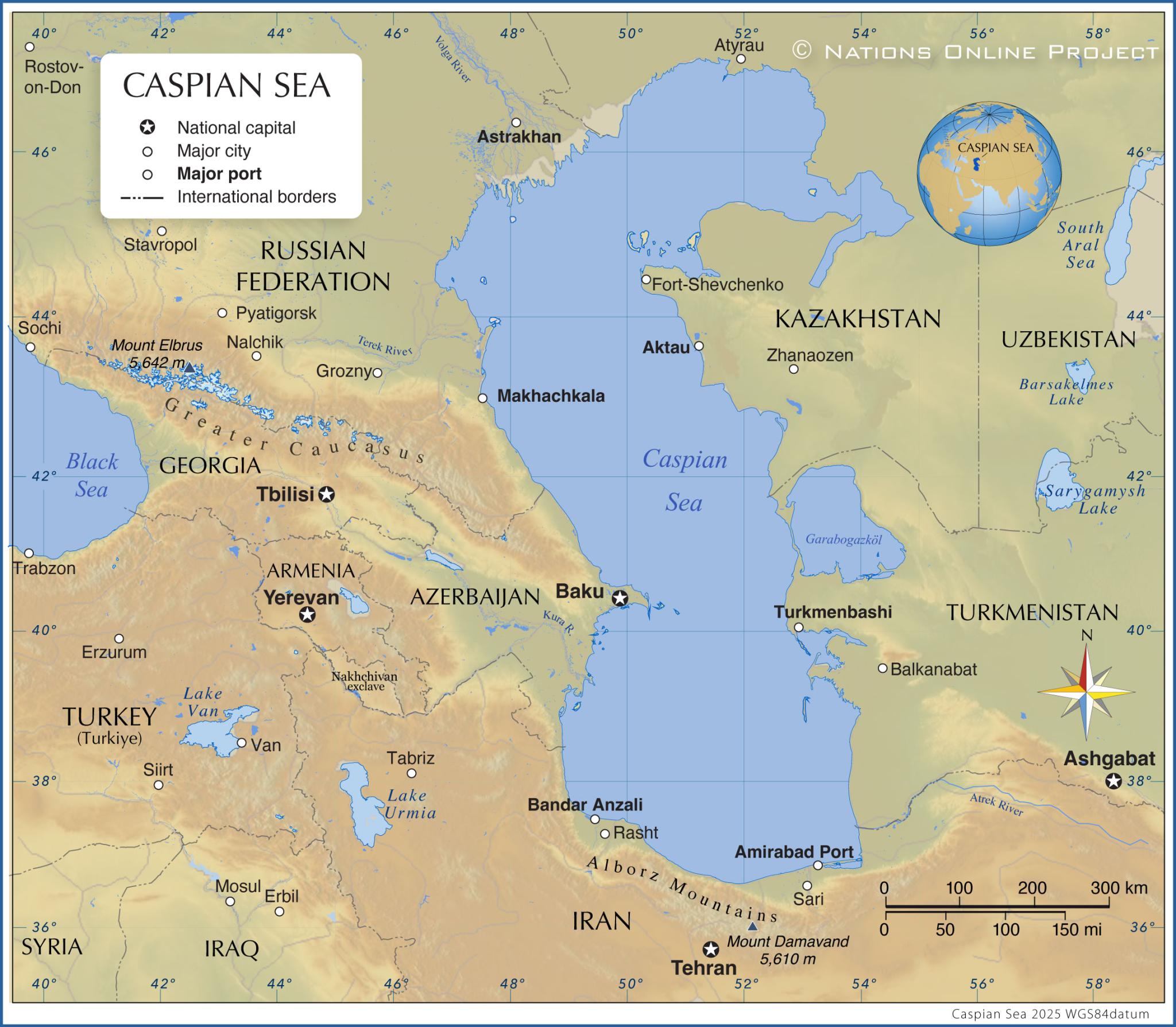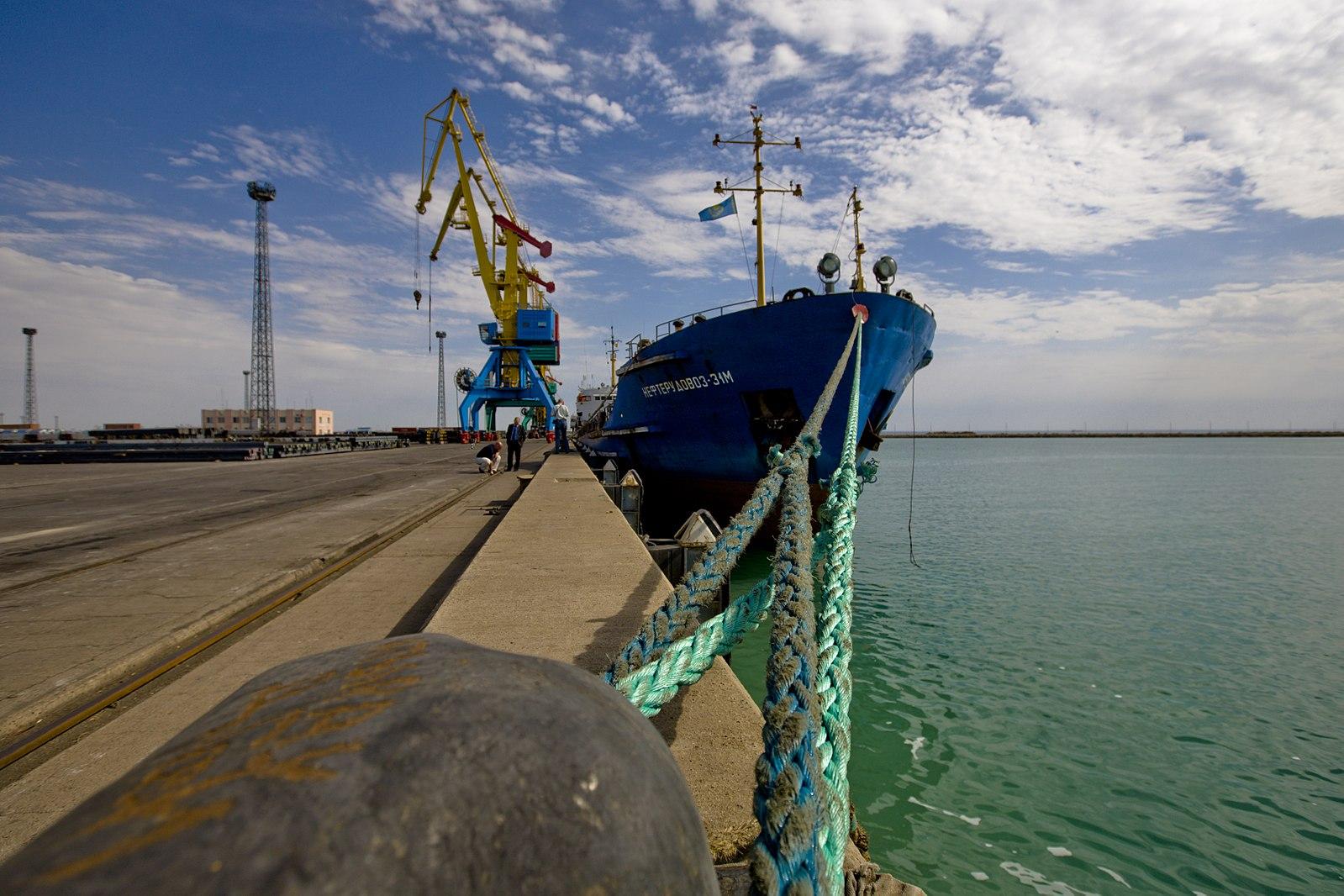Alina Zafar
Erasmus University Rotterdam
A Landlocked Nation’s Global Ambitions
Aktau is Kazakhstan’s lone window to the Caspian Sea. It makes an intriguing case of a port globally tethered to a landlocked nation’s ambitions. Unlike Europe’s delta cities or major container hubs, Aktau arose for one reason only: to tap the region’s mineral and energy resources. Since 1963 its raison d'être has been rooted in the mineral wealth beneath its sands, being built as a Soviet uranium and oil mining hub (Beifert & Moldabekova, 2024). Today, the city is trying to transcend its industrial cradle and position itself as a linchpin of Eurasia’s New Silk Road—a geopolitical pivot where steel rails and hydrocarbon tankers link continents (Prause, 2024).
However, this outward-facing ambition covers deep internal tensions. Transport infrastructure initiatives are crucial for a country long constrained by what Blainey (1996) called the "Tyranny of Distance," a condition reflected in Kazakhstan’s 79th place on the World Bank’s Logistic Performance Index (2023). Yet, behind its logistical aspirations, Aktau remains a city pressured not just by the weight of its ambitions, but by the unequal distribution of their fruits. This case is not confined to oil revenues and transcontinental corridors; it is fundamentally about the impact of growth models that struggle to retain value locally and the human cost of development shaped by colonial history and multinational corporations.

Oil Wealth Meets Social Fracture
The collapse of the Soviet Union and access to a global liberal market proved weak in changing the region’s driving force: hydrocarbons. Western Kazakhstan—home to the sprawling Tengiz oil field, a joint venture with Chevron—epitomizes the region’s paradox: economic growth fueled by foreign investment exists alongside deep social discontent. In January 2022, protests over rising LNG prices led to nationwide turmoil, with Mangystau Province, Aktau’s hinterland, at the epicentre (Vaal, 2022). For Chevron executives and the Kazakh government, Tengiz is routinely held up as a success story of East-West cooperation (‘Twenty Years of Kazakhstan Independence and US-Kazakhstan Relations’, 2012). Yet the region faced 150 labor disputes in 2021 alone, revealing cracks in Kazakhstan’s “New Silk Road” narrative (Abubakarova, 2021).
This unrest is rooted in systemic inequality. Despite contributing 70% of the country’s oil revenue, western Kazakhstan remains chronically underdeveloped. In 2022, workers at Tengiz, where 39,000 jobs were at stake as the Future Growth Project (FGP) neared completion, faced insecure contracts, wage disparities, and hazardous working conditions (Yakhyarova, 2022). Anxieties in Aktau’s oil-dependent hinterland have been intensified with Chevron’s announcement to slash 20% of its global workforce by 2026, including jobs in Kazakhstan (Sherman, 2025). This move is framed as a part of a $2–3 billion cost-saving strategy. But it comes despite a 6% annual production increase from new Kazakh wells, underscoring the growing disconnect between corporate profit imperatives and local livelihoods (Sherman, 2025). Thus, the gap between external gain and local value retention continues to widen.
Corridors of Growth
It is against this backdrop of internal inequality that Aktau's infrastructure ambitions must be understood. Ports are more than logistical gateways; they shape the urban and regional landscapes, embodying the "port city territory" concept where influence extends far beyond the waterfront (Nefs, 2024). Aktau, despite its relatively small size, plays a comparably large strategic geopolitical role. At the heart of its transformation lies the Dostyk-Aktau railway, a 1,146km conduit linking China’s Xinjiang to the Caspian Sea as part of the Trans-Caspian International Transport Route (TITR). This artery bypasses Russia, cuts transit times, and positions Aktau as a key node in the Middle Corridor network connecting Xi’an to Baku (Tekir, 2022). Aktau Port itself processes 1.55 million tons of dry cargo annually.
Yet, this focus on external connectivity and geopolitical significance often overshadows the limited local value capture. Aktau primarily handles lower-value goods ($0.40 – 3.10/kg), compared to major hubs moving high-tech trade ($7.40 – 10.70/kg), limiting both global competitiveness and the economic multipliers for the region (Rasa & Haq, 2023). Furthermore, like many small ports, it faces internal constraints from shallow berths and limited capacity to rising environmental pressures and the social tensions already highlighted (Yeltay, 2023). Aktau is thus not simply Kazakhstan’s maritime outlet, but a nexus where contested territorial ambitions and global infrastructure logic collide with the urgent need for internal consolidation and regional equality.

Unequal Contracts and Shifting Legal Frameworks
Injustice in the petrofield is not peculiar to lower social strata: it is embedded in the state-level contracts concluded decades ago. In a way, Kazakhstan fell into the trap of internal colonialism, downplaying the population's intrinsic value for the sake of investors' comfort. However, we need to bear in mind the inexperience of newly independent Kazakhstan in the 1990s, particularly in negotiating with large, experienced transnational corporations like Chevron. The country’s extreme need for foreign investment to maintain production also left government officials little choice but to accept disadvantageous contracts.
Over time, however, there has been some positive progress. Reforms such as the 2017 Law "On Subsoil and Subsoil Use" as well as more transparent Production Sharing Agreements in the sector, marked an important shift toward greater national control and transparency over Kazakhstan’s natural wealth. In 2023, the government reinstated Aktau Port’s international status, and in 2024, a $66 million oil terminal, unlawfully privatized during the earlier transition years, was returned to state ownership (Antonov, 2024; Ualikhanova, 2023). These actions not only addressed longstanding issues of opaque ownership but also signaled a renewed political will to protect strategic assets and ensure they operate in line with national and regional development goals.
Who Speaks for the Workers?
State-level lack of expertise is not the only bottleneck of the system. It is hard to overestimate the negative effect of the deficient corporate culture in both domestic and foreign oil extraction and service companies. A key reason is the stagnation of labor union development. The erosion of worker advocacy has only exacerbated tensions.
In the 1990s, Tengizchevroil (TCO) saw relative peace under Togzhan Kizatova’s independent union, which fought for local representation (Yessenova, 2012). That changed in 2003, when management replaced it with a toothless “white-collar” body. Today, fragmented subcontracting stifles collective bargaining, causing distrust among workers (Zhussupova, 2021).
However, the potential to revive this social institution remains. What is needed is not only legal reforms to protect union activity and collective bargaining but also investment in worker education, regional union networks, and tripartite dialogue between the state, employers, and labor. As was seen during the January 2022 protests, workers from different regions, although not formally organized, were united with solidarity. Tengiz workers backed Zhanaozen demonstrators, signalling a demand for accountability (Vaal, 2022).
Just Transitions, Not Just Growth
In conclusion, beyond the first-look difference of being a port in a landlocked country, Aktau embodies the paradox common to port cities in the Global South: on its way to a transnational hub, yet a crucible of local dissent. This case reveals an urgent need to redefine "port development". Success can no longer hinge solely on tonnage or transit speed. Ports like Aktau must become laboratories for just transitions, where infrastructure expansion goes hand in hand with social innovation. This can enable the creation of green jobs, foster participatory governance, and build circular economies that retain value locally.
Acknowledgment
This blog post has been written in the context of discussions in the LDE PortCityFutures research community. It reflects the evolving thoughts of the author and expresses the discussions between researchers on the socio-economic, spatial and cultural questions surrounding port city relationships. This blog was edited by the PortCityFutures editorial team: Yi Kwan Chan and Eliane Schmid. In particular, we thank Carola Hein for her valuable inputs and comments.
References
Abubakarova, T. (2021). Tokaev o trudovykh konfliktakh v Mangistauskoy oblasti: Vse spory dolzhny byt’ resheny v ramkakh zakona [Tokayev on labour conflicts in Mangystau Region: All disputes must be resolved within the law]. Informburo. https://informburo.kz/novosti/tokaev-o-trudovyh-konfliktah-v-mangistauskoj-oblasti-vse-spory-dolzhny-byt-resheny-v-ramkah-zakona
Antonov, N. (2024, June 4). Oil terminal in Aktau returned to the state. Ports Europe. https://www.portseurope.com/oil-terminal-in-aktau-returned-to-the-state
Beifert, A., & Moldabekova, A. (2024). The Readiness of Port Logistics Services in the Caspian Sea Within the Eurasian Transport Corridor – Case Study of the Port of Aktau. In I. Kabashkin, I. Yatskiv, & O. Prentkovskis (Eds.), Reliability and Statistics in Transportation and Communication (pp. 233–246). Springer Nature Switzerland. https://doi.org/10.1007/978-3-031-53598-7_21
Blainey, G. (1996). The tyranny of distance: How distance shaped Australia’s history (Rev. ed.). Sun.
Joseph, J. (2019, January 3). BRI: Six economic corridors of power. Standard Chartered. https://www.sc.com/en/news/corporate-investment-banking/one-masterplan-six-corridors/
Nefs, M. (2024, March 15). Interpreting the Port City Atlas. PortCityFutures. https://www.portcityfutures.nl/news/interpreting-the-port-city-atlas
Prause, G. (Ed.). (2024). The South Caucasian transport corridor: A new Eurasian transport option. Hochschule Wismar, Fakultät für Wirtschaftswissenschaften.
Rasa, M. M., & Haq, I. (2023, September 9). Diversifying Transport and Transit Routes in Central Asia: Key Insights [MPRA Paper]. https://mpra.ub.uni-muenchen.de/123542/
Sherman, N. (2025, February 12). Chevron to cut as much as 20% of workforce. BBC. https://www.bbc.com/news/articles/c8ed3n1zw05o
Tekir, G. (2022). Economic and Political Impacts of the Belt and Road Initiative on Kazakhstan,4, 60–69.
Twenty Years of Kazakhstan Independence and US-Kazakhstan Relations: 1/31/2012 - Final Session. (2012, January 31). Atlantic Council. https://www.atlanticcouncil.org/commentary/transcript/twenty-years-of-kazakhstan-independence-and-uskazakhstan-relations-1-31-2012-final-session/
Ualikhanova, A. (2023, September 26). Aktau Sea Trade Port Regains International Status. The Astana Times. https://astanatimes.com/2023/09/aktau-sea-trade-port-regains-international-status/
Vaal, T. (2022, January 4). Sotni neftyanikov na Tengize vyshli na aktsiyu v podderzhku protestuyushchikh v Mangistau. [Hundreds of oil workers at Tengiz stage a protest in support of demonstrators in Mangistau]. Vlast. https://vlast.kz/novosti/48016-sotni-neftanikov-na-tengize-vysli-na-akciu-v-podderzku-protestuusih-v-mangistau.html
Yakhyarova, D. (2022, April 8). Rabotnikov “Tengizshevroyla” budut sokrashchat’ v chetyre etapa do kontsa goda [Tengizchevroil workers will be laid off in four stages by the end of the year]. Orda. https://orda.kz/rabotnikov-tengizshevrojla-budut-sokrashhat-v-4-jetapa-do-konca-2022-goda/
Yeltay, A. (2023). Verification of the Results of the Swan Model for the Water Area near Port Aktau. International Journal of GEOMATE, 25(109). https://doi.org/10.21660/2023.109.m2305
Yessenova, S. (2012). The Tengiz Oil Enclave: Labor, Business, and The State. Political and Legal Anthropology Review, 35(1), 94–114. World Bank. (2023). 2023 | Logistics Performance Index (LPI). https://lpi.worldbank.org/international/global
Zhussupova, A. (2021, December 10). Why is There an Increase in Social and Labor Conflicts in Kazakhstan? CABAR.Asia. https://cabar.asia/en/why-is-there-an-increase-in-social-and-labor-conflicts-in-kazakhstan
